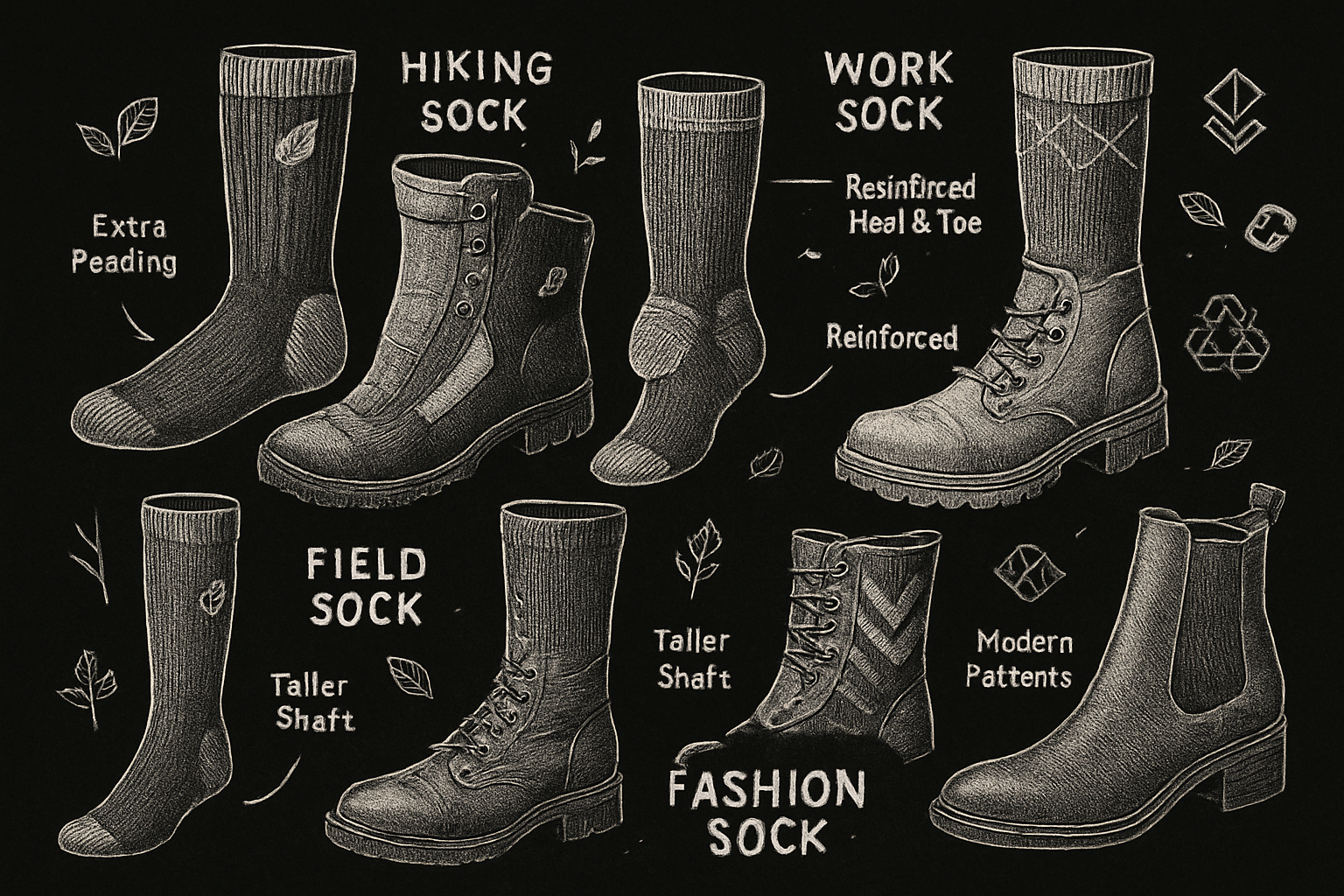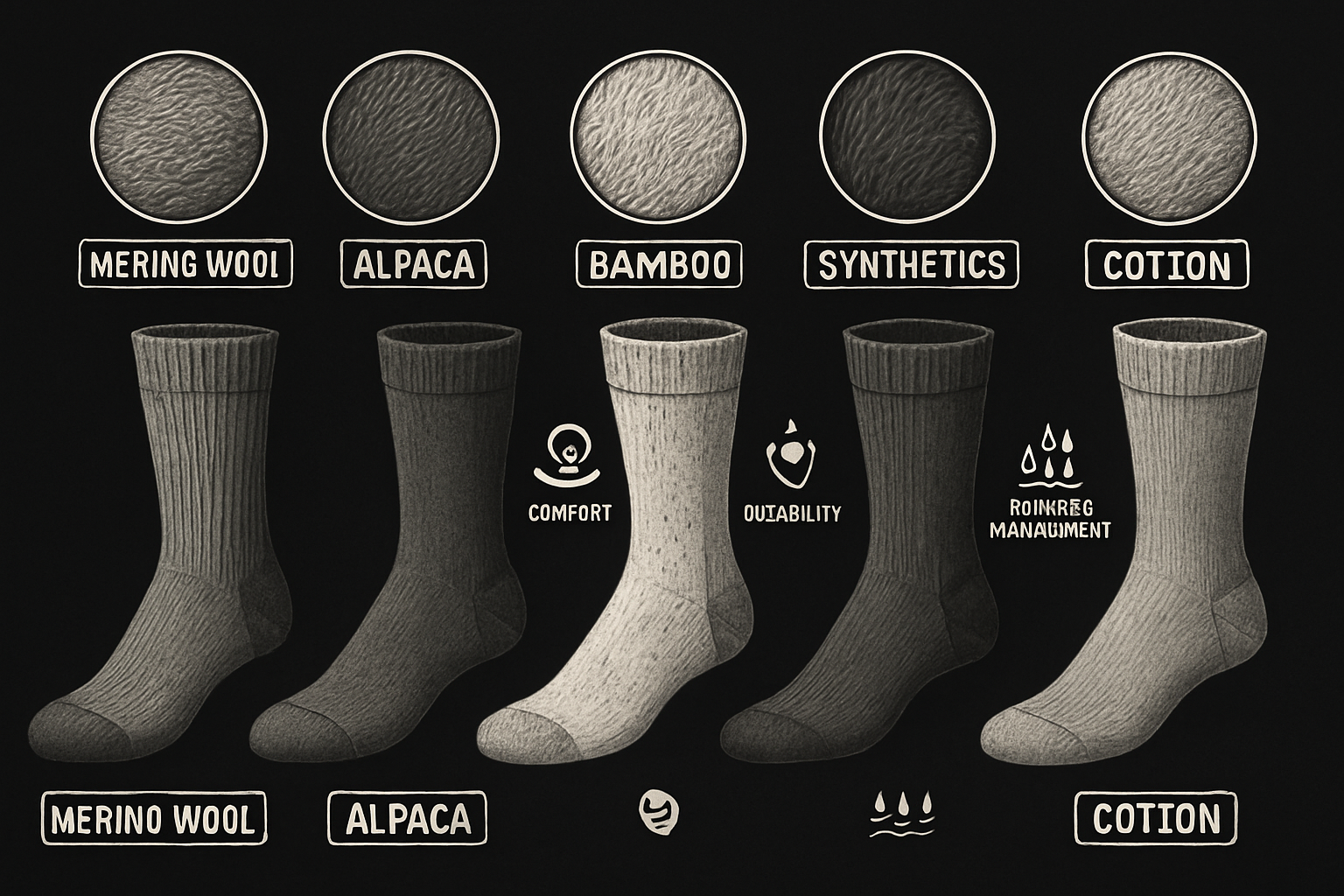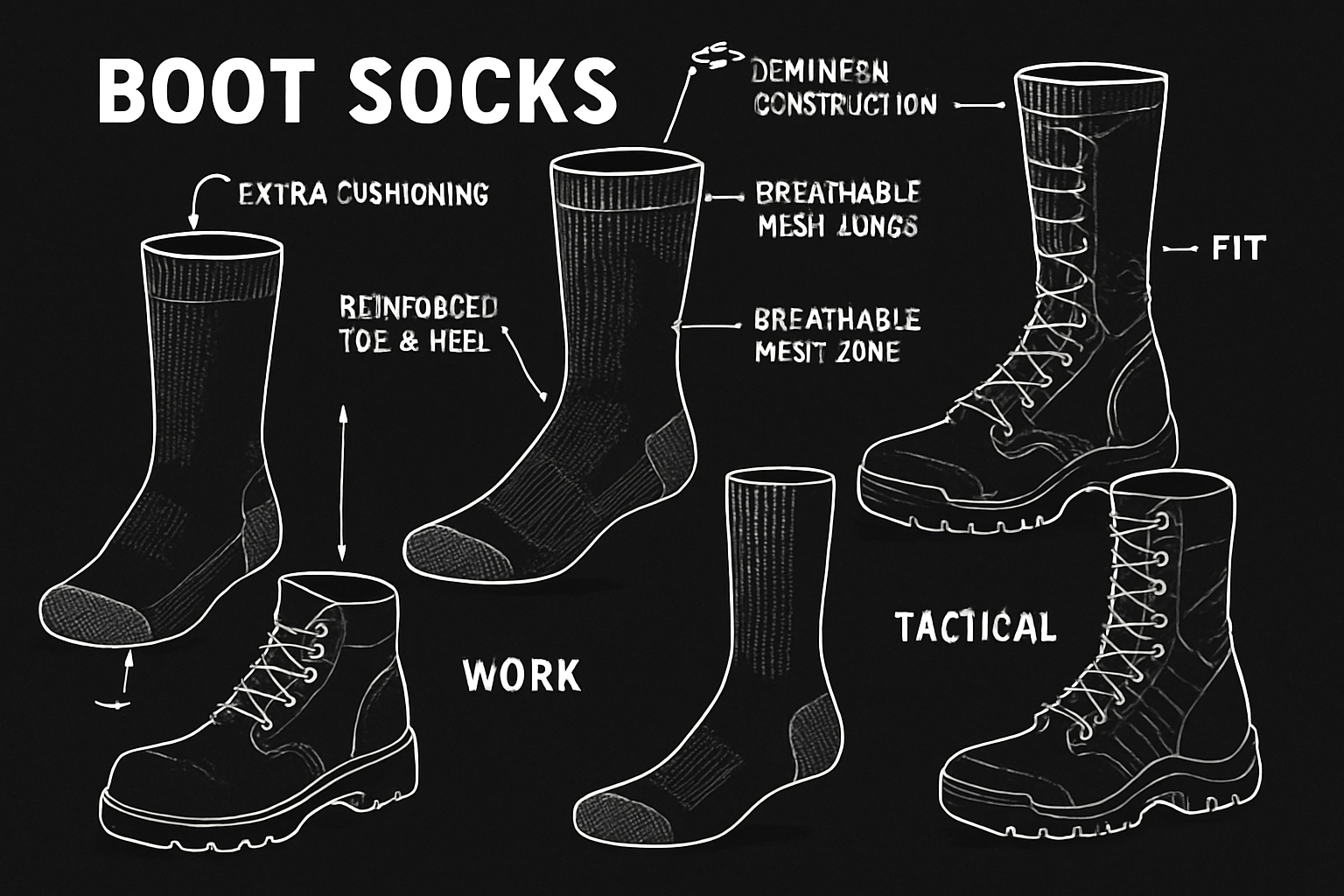Boot Socks Guide: How to Choose the Best Pair in 2025
Have you ever wondered if your boots are only as good as the boot socks you choose? Wearing the right boot socks can instantly elevate your comfort and make a world of difference in everyday activities or outdoor adventures. Poor-quality options often lead to blisters, sweaty feet, or aching arches, but selecting the perfect pair can transform your experience.
In this guide, you’ll discover the latest trends, materials, and expert tips for 2025. We’ll break down what makes a great boot sock, how to spot the best features, and which brands stand out. Ready to finally find your perfect fit? Let’s get started.
Understanding Boot Socks: What Sets Them Apart?
When it comes to comfort and performance, not all socks are created equal. Boot socks are specially designed to meet the demands of wearing boots, making a noticeable difference in how your feet feel throughout the day. The right pair can manage moisture, provide extra protection, and deliver warmth, whether you're hiking, working, or simply enjoying the outdoors. According to recent surveys, more than 80% of outdoor enthusiasts agree that socks are critical for comfort—and boot socks stand out as a game-changer.

Definition and Purpose of Boot Socks
Boot socks differ from regular socks in several key ways. They are crafted specifically for use with boots, featuring a higher rise that prevents rubbing and keeps debris out. Added cushioning and durable fabrics set them apart, offering essential moisture management, protection, and reliable warmth.
You’ll find boot socks in a range of styles for different needs: hiking socks for rugged trails, work socks for long shifts, and field socks for outdoor pursuits. If you're curious about the latest designs and materials available, check out the Boot Socks Collection to see a wide array of options.
Key Features Unique to Boot Socks
What makes boot socks unique is their thoughtful construction. Reinforced heels and toes ensure extended wear, while extra padding helps prevent blisters and absorbs shock on tough terrain. The taller shaft protects your legs from boot abrasion and keeps out dirt and debris.
A snug fit is essential to avoid slipping, and many boot socks incorporate breathable zones for optimal temperature regulation. These features work together to deliver comfort and durability, especially during demanding activities.
Types of Boot Socks by Activity
Boot socks come in different types, each tailored to a specific activity:
- Hiking boot socks: Moisture-wicking, cushioned for long distances.
- Work boot socks: Durable, supportive, and often anti-odor.
- Field/hunting socks: Insulated, sometimes in camouflage colors.
- Everyday boot socks: Comfortable and stylish for casual wear.
- Tactical/military boot socks: Compression and quick-drying properties.
Choosing the right boot socks for your needs ensures you get the best performance and comfort, no matter your environment.
Boot Sock Trends for 2025
Looking ahead to 2025, boot socks are evolving with the latest trends. Sustainable materials and eco-friendly production methods are in high demand, as consumers seek greener options. Advanced moisture-wicking and antimicrobial technologies are becoming standard, while customizable fits and ergonomic designs enhance comfort.
Bold patterns and a wider range of colors are also making their mark. Data shows a growing preference for natural fibers like merino wool and bamboo, reflecting a shift toward both performance and sustainability in boot socks.
Choosing the Right Material: Comfort, Performance, and Durability
Selecting the right material is crucial when investing in boot socks. Each fiber brings unique benefits to your comfort, performance, and overall boot experience. Let’s break down the most popular options for 2025 so you can step confidently into any adventure.

Overview of Common Boot Sock Materials
When shopping for boot socks, you'll find several core materials leading the market. Merino wool stands out for its softness, breathability, and ability to regulate temperature. Alpaca offers ultra-warmth, hypoallergenic comfort, and natural moisture resistance.
Bamboo is an eco-friendly choice, delivering a silky feel and antibacterial properties. Synthetic blends, such as polyester and nylon, provide durability, quick-drying action, and affordability. Cotton remains a classic, praised for its softness, though it’s less effective at wicking moisture. Each of these materials has a place in the world of boot socks, depending on your needs.
Pros and Cons of Each Material
Every boot socks material brings advantages and drawbacks. Merino wool excels in all seasons but comes at a higher price. Alpaca is even warmer and softer, though less widely available. Bamboo feels gentle on sensitive skin but may not last as long under heavy use.
Synthetics shine for high-intensity activities, offering toughness and faster drying, but they can sometimes trap odors. Cotton is budget-friendly and comfortable for everyday wear, yet it falls short when you need strong moisture control. Here’s a quick side-by-side:
| Material | Pros | Cons |
|---|---|---|
| Merino Wool | Breathable, regulates temp | Costlier |
| Alpaca | Warm, hypoallergenic | Less common |
| Bamboo | Soft, antibacterial | Less durable |
| Synthetics | Durable, quick-drying | Odor retention |
| Cotton | Soft, affordable | Poor moisture wicking |
Material Selection by Use Case
Matching the right material to your needs ensures your boot socks deliver optimum comfort and performance. For hiking, merino wool or blended options control moisture and reduce blisters. Work environments demand thick wool or synthetic blends for durability.
Everyday wear leans toward cotton blends or bamboo for all-day comfort. Cold climates call for alpaca or heavyweight wool. In hot weather, lightweight merino or bamboo keeps feet cool. For an in-depth guide on material thickness and boot compatibility, the Thick Socks for Boots Guide offers practical tips to help you choose the perfect pair.
Innovations in Boot Sock Materials for 2025
The boot socks market is evolving rapidly, with brands introducing sustainable blends like recycled polyester combined with merino wool. Smart fibers that adapt to temperature changes are emerging, offering next-level comfort.
Enhanced antimicrobial treatments are becoming standard, further minimizing odor and maintaining freshness. Some brands now offer recycled merino wool socks with added stretch to improve fit retention and longevity. These innovations make boot socks smarter, greener, and more versatile than ever.
The Role of Natural Fibers in Modern Boot Socks
Natural fibers are making a major comeback in boot socks, as consumers demand skin-friendly and sustainable options. Merino wool remains the gold standard for premium boot socks, prized for its breathability and odor resistance.
Recent surveys show that 60% of outdoor enthusiasts prefer natural fiber socks for their superior comfort and performance. As sustainability takes center stage, expect natural materials to play an even bigger role in the future of boot socks.
Essential Boot Sock Features: What to Look For
When shopping for boot socks, it’s easy to get lost in a sea of options. The right pair can make all the difference, whether you’re hitting the trails, heading to work, or just want all-day comfort. Let’s break down the essential features that set top-quality boot socks apart, so you can step confidently into 2025.

Cushioning and Padding
Cushioning is at the heart of what makes boot socks comfortable. Without adequate padding, your feet absorb more impact from every step, leading to fatigue or even blisters. Boot socks typically offer varying levels of cushioning—light for everyday wear, medium for hiking, and heavy for demanding field work.
Key placement areas include the heel, toe, and underfoot. For those braving cold or rugged conditions, extra-heavyweight boot socks provide added protection and warmth. If you want more tips on keeping your feet comfortable in winter, check out these Winter Boot Socks Tips.
Choosing the right level of padding in your boot socks helps prevent discomfort and supports your every adventure.
Fit and Compression
A proper fit is essential for boot socks. Ill-fitting socks can slip, bunch, or cause blisters, which can ruin your day. Look for compression zones around the arch and calf—these offer support, improve circulation, and keep the socks securely in place.
Boot socks come in a range of sizes for men, women, and unisex options. Over-the-calf designs are popular for maximum support with taller boots. Always try your boot socks with the boots you plan to wear to ensure a snug but not restrictive fit.
Compression features in boot socks can also help reduce swelling during long hours on your feet.
Moisture Management and Breathability
No one likes sweaty feet. Quality boot socks use moisture-wicking fibers to draw sweat away from your skin, keeping your feet dry and reducing the risk of blisters. Look for mesh zones or ventilated panels that enhance airflow.
Many boot socks now include antimicrobial treatments to fight odor-causing bacteria. Data shows that 9 out of 10 hikers report fewer blisters when wearing moisture-wicking boot socks. This feature is especially crucial for those who spend long hours outdoors or in demanding work environments.
Proper moisture management in boot socks can be the key to all-day freshness and comfort.
Durability and Reinforcement
Boot socks are built to last, but only if they’re reinforced in the right places. Look for double-stitched toes and heels, as these areas see the most wear and tear. Some boot socks even use double-layer construction for added toughness, especially in work or field settings.
High-stress zones should have extra reinforcement to prevent holes and extend the life of your socks. For demanding jobs or outdoor adventures, wool-heavyweight boot socks are a popular choice for their rugged durability.
Choosing durable boot socks ensures you get the most out of every pair, even in the harshest conditions.
Shaft Height and Coverage
The height of your boot socks matters more than you might think. Mid-calf and over-the-calf styles offer different levels of coverage, suited to your boot type and activity. Taller boot socks protect against debris, abrasion, and cold—ideal for hunting, fieldwork, or tactical use.
If you’re wearing shorter boots or want a more casual look, mid-calf boot socks are a great match. Always pick the shaft height that matches your activity and the boots you wear most.
Boot socks with the right coverage keep your feet and lower legs shielded from the elements.
Seam Construction and Comfort
The smallest details make a big difference in boot socks. Flat or seamless toe designs help prevent chafing and irritation, especially during long days on your feet. Soft top bands are gentle on the calf and avoid constriction, while a smooth interior is best for sensitive skin.
Some boot socks are designed with special soft-top features for all-day comfort, accommodating those with circulation concerns. Always inspect the seams and interior finish before committing to a pair.
Prioritizing comfort details in your boot socks ensures you can focus on your day, not your feet.
Sizing, Fit, and Gender-Specific Considerations
Choosing the right size and fit for your boot socks is essential for day-long comfort and performance. Ill-fitting socks can quickly turn a great pair of boots into a source of discomfort or even pain. Let’s break down how to get the best fit for every foot and activity.

How to Measure and Choose the Right Size
Finding the ideal size in boot socks starts with accurate foot measurements. Use a soft measuring tape to measure the length of your foot from heel to toe, and note your foot’s circumference at the widest point. Always check the manufacturer’s sizing chart, as sizing can vary between brands and regions.
Try on boot socks with the boots you plan to wear. This helps you confirm the fit isn’t too tight or loose. If shopping internationally, remember sizing differences, such as US versus UK standards. Here’s a quick comparison:
| Region | US Size | UK Size | EU Size |
|---|---|---|---|
| Men | 10 | 9 | 44 |
| Women | 8 | 6 | 39 |
Properly fitted boot socks should hug your foot without bunching or slipping.
Men’s vs. Women’s Boot Socks
Manufacturers design men’s and women’s boot socks to accommodate anatomical differences. Men’s versions typically have a wider toe box and more room in the calf, while women’s styles often feature a narrower heel, softer fabrics, and smaller overall sizing.
For many, these subtle changes make a noticeable difference in fit and comfort. Women’s boot socks may also offer more color and pattern options. Trying both gender-specific and unisex styles can help you determine the best fit for your feet and boots.
Some brands even provide extra support zones for the arch or ankle, tailored to the needs of each gender. Don’t hesitate to experiment to find your perfect match in boot socks.
Unisex and Kids’ Boot Socks
Unisex boot socks offer flexibility, designed to fit a broad range of foot shapes and sizes. They’re a practical choice for families or anyone who prefers a standard fit. For kids, sizing is especially important—look for socks with a little growth room, but not so much that they bunch up.
Children’s boot socks often feature extra cushioning for comfort and reinforced toes for durability. Colorful patterns and fun designs can also help kids get excited about wearing the right socks for their boots.
When shopping for unisex or kids’ boot socks, always check the size chart and consider any special features like anti-slip grips or added padding for active youngsters.
Adjusting Fit for Different Boot Types
Different boots require different types of boot socks for optimal comfort. Hiking boots pair well with snug, cushioned socks that prevent blisters. Work boots often need thicker boot socks for extra padding and support.
For fashion boots, thinner socks with stylish designs can help maintain a sleek look while still offering comfort. Tall or tactical boots benefit from over-the-calf boot socks, which provide added coverage and protection.
Selecting the right boot socks for each boot style ensures your feet stay supported and comfortable throughout any activity. If you’re curious about how sizing and variety are evolving, you can explore the Socks Market Size and Forecast for more industry insights.
Boot Socks for Every Activity: Matching Socks to Your Needs
Finding the right boot socks for your activity can make all the difference. Whether you’re scaling a mountain, working long shifts, or simply looking for all-day comfort, the ideal pair exists to suit your needs.
Hiking and Outdoor Adventures
Hiking demands boot socks that keep your feet dry, cushioned, and protected from blisters. Look for moisture-wicking fibers like merino wool or high-performance synthetics. These materials help manage sweat and temperature shifts on tough trails.
- Extra cushioning in the heel and toe absorbs impact on rocky paths.
- A snug fit prevents slippage, minimizing friction and blisters.
- Taller shafts keep debris out during off-road treks.
For multi-day hikes or mountain adventures, heavyweight boot socks provide essential comfort and durability.
Work and Safety Boots
If you spend hours on your feet in work boots, durability and support are non-negotiable. Boot socks for work typically feature reinforced heels and toes, plus padded soles to absorb shock from concrete or uneven ground.
- Anti-odor treatments keep feet fresh during long shifts.
- Thicker materials like wool or sturdy synthetics withstand heavy use.
- Compression zones offer extra support for arch and ankle.
A reliable pair of work boot socks can reduce fatigue and protect against workplace hazards.
Hunting and Field Use
For hunting or fieldwork, boot socks need to deliver warmth, camouflage, and scent control. Insulating materials like heavyweight wool or specialized blends trap heat in cold, damp conditions.
- Over-the-calf height shields against brush, insects, and mud.
- Camouflage colors help you blend into your environment.
- Scent-masking technology reduces human odor for stealth.
Extra-heavyweight boot socks are ideal for long days in the wild, keeping your feet warm and protected.
Everyday and Fashion Boots
Everyday boot socks blend comfort, breathability, and style. Lighter-weight materials such as bamboo or cotton blends are perfect for casual wear, especially when paired with fashion boots.
- Choose thinner boot socks for a sleek fit with dressier boots.
- Modern options come in a variety of patterns and colors.
- Enhanced breathability keeps feet cool throughout the day.
Emerging trends for 2025, like sustainable fibers and bold designs, are shaping the next generation of boot socks for daily wear.
Tactical and Military Boots
Tactical environments require boot socks that deliver compression, quick-drying performance, and durability. Synthetic blends excel here, often incorporating advanced moisture-wicking and antimicrobial features.
- Over-the-calf coverage meets uniform standards and protects calves.
- Compression zones increase circulation and reduce muscle fatigue.
- Reinforced construction withstands demanding conditions.
For those on the move, tactical boot socks provide the support and resilience needed for every mission.
Top Boot Sock Brands and What Sets Them Apart
Choosing the right boot socks often starts with knowing which brands deliver on comfort, durability, and innovation. With so many options on the market, finding the perfect pair is easier when you know who leads the way and what makes them stand out.
Overview of Leading Boot Sock Brands
Several brands have set the standard for boot socks by consistently delivering quality and performance. Darn Tough is famous for its rugged construction and legendary lifetime guarantee, making it a go-to for outdoor enthusiasts. Fox River is a trusted name, offering a broad selection for both work and outdoor needs, with an emphasis on American-made craftsmanship.
Smartwool has pioneered merino wool boot socks, winning fans for their softness and temperature regulation. Wigwam, another American classic, combines nostalgia with modern technology to create reliable socks for every boot. These brands not only offer a wide variety of boot socks, but also back their products with strong warranties and excellent customer service.
Comparing Features and Quality
When comparing boot socks across leading brands, several features set the best apart. Material quality is crucial: top brands use premium merino wool, reinforced synthetic fibers, and advanced blends. Durability is another key factor, with reinforced heels and toes, double-stitched seams, and high-density cushioning.
| Brand | Notable Feature | Guarantee |
|---|---|---|
| Darn Tough | Lifetime warranty, durability | Unconditional |
| Smartwool | Merino innovation | Satisfaction |
| Fox River | Versatile, American-made | 1-year limited |
| Wigwam | Classic designs | 2-year limited |
Customer reviews often highlight the comfort and long life of these boot socks, making them a solid investment for anyone needing reliable performance.
Sustainable and Ethical Boot Sock Brands
Sustainability is a growing priority for both brands and consumers when it comes to boot socks. Leading companies like Smartwool are making strides by using recycled or organic materials and implementing ethical manufacturing practices. Certifications such as OEKO-TEX and Fair Trade are increasingly common among top-tier brands.
Eco-conscious buyers are drawn to brands that prioritize both environmental responsibility and quality. Smartwool, for example, has made a public commitment to responsible sourcing and transparency. Many brands now offer boot socks made from recycled yarns or natural fibers, meeting the demand for green alternatives without sacrificing comfort or durability.
How to Spot Counterfeits and Low-Quality Socks
With the rising popularity of premium boot socks, counterfeits and cheap imitations are a real concern. Warning signs include poor stitching, inconsistent sizing, and a lack of reinforcement in high-wear areas. To avoid disappointment, always purchase from authorized retailers and double-check product details.
Price can signal quality, but it isn’t the only factor. Be cautious if the deal seems too good to be true. According to the Global Socks Market Growth Projections, one in five online sock purchases is counterfeit, underscoring the need for vigilance when shopping for authentic boot socks.
Boot Sock Care: Maximizing Lifespan and Performance
Keeping your boot socks in top condition is the key to getting the most out of your investment. Proper care not only extends their lifespan but also maintains their comfort and performance. Whether you're wearing boot socks daily or saving them for special adventures, a few simple steps can make a big difference in how long they last.
Washing and Drying Best Practices
To keep your boot socks performing at their best, start with the right washing routine. Always separate boot socks by color and material, as natural fibers like wool or mohair require gentler care than synthetics. Use cold water and a mild detergent to prevent shrinking and fading.
Turn boot socks inside out before washing. This step helps remove sweat and dirt from the inside while protecting the outer fibers. Avoid using fabric softeners, as they can coat fibers and reduce moisture-wicking abilities.
Skip the high heat when drying. Air drying is best for materials like wool, alpaca, and mohair. Lay boot socks flat on a clean towel or drying rack to help them retain their shape and softness.
Storage and Organization Tips
Organizing your boot socks properly can help preserve their elasticity and prevent stretching. Store boot socks flat or gently rolled, rather than folding them in half, which can create permanent creases.
Choose a cool, dry, and well-ventilated drawer or storage bin. Moisture and heat can degrade fibers over time, especially in natural materials. Use drawer dividers to keep different types of boot socks separate, making it easy to grab the perfect pair for any activity.
If you have a large collection, consider rotating your boot socks regularly. This habit ensures even wear and extends the overall life of each pair.
Repairing and Maintaining Boot Socks
Even high-quality boot socks can develop minor holes or thinning areas with frequent use. Instead of tossing them, try simple repairs like darning. Use matching thread and a darning needle to reinforce weak spots, especially at the heel and toe.
If you wear specialty materials such as mohair, choose gentle repair techniques to keep the unique fibers intact. For example, the Mohair Boot Sock Bundle demonstrates the durability and repairability of premium boot socks.
Regularly inspect your boot socks for signs of wear and address minor issues early. This proactive approach keeps your favorite pairs in action longer.
Signs It’s Time to Replace Your Boot Socks
Knowing when to retire your boot socks is crucial for comfort and foot health. Watch for persistent odors that don't wash out, even after several gentle cycles. This can be a sign that bacteria or residue has built up in the fibers.
Look for visible holes, thinning fabric, or sagging elastic. If your boot socks no longer provide cushioning or begin to slip inside your boots, it's time for an upgrade.
For heavy daily use, consider replacing boot socks annually. Keeping a fresh rotation ensures ongoing support and performance.
Tips for Traveling and Outdoor Storage
When packing for a trip or outdoor adventure, always bring extra pairs of boot socks. Changing into a dry pair can prevent blisters and keep your feet healthy in unpredictable conditions.
Store boot socks in a mesh bag to promote airflow and reduce odor buildup. If you're backpacking or camping, keep your boot socks in a waterproof pouch to protect them from rain or damp gear.
After a long day, air out your boot socks overnight. This simple habit helps them dry thoroughly and stay ready for your next adventure.


